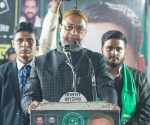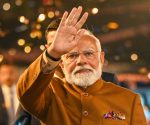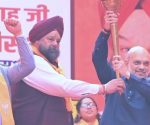In Delhi’s political win, BJP gets a governance gift | Latest News India

Seven months: That is the gift Delhi’s outcome has given to the Bharatiya Janata Party and the BJP-led central government.

For the next seven months, till the campaign intensifies in the final lap of the Bihar elections, the BJP does not have to worry about winning elections. It does not have to worry about its political reputation and strength that was depleted after the Lok Sabha polls, for it has now shown not once, not twice, but thrice — in Haryana, Maharashtra, and now Delhi — that the 2024 verdict was not necessarily the beginning of the end.
Also read | Delhi election result LIVE updates
It does not have to worry about a united opposition mounting a concerted attack, for these three electoral setbacks will only intensify the contradictions within the Indian National Developmental Inclusive Alliance (INDIA) bloc. And it does not have to worry about an expansion in Arvind Kejriwal’s national footprint in the foreseeable future, a possibility a decisive Aam Aadmi Party (AAP) victory in adverse circumstances may well have thrown up.
Also Read: Decoding BJP’s stunning victory in Delhi elections
The BJP does not have to worry about any disequilibrium in its internal equations within the party; there is absolute clarity that Narendra Modi is supreme, Amit Shah runs the machine and everyone else derives their power from the duo. It does not have to worry about clashes with the wider ideological family, for the post-Lok Sabha reset in ties and closer consultation and coordination is working in the Sangh’s centenary year. And it does not have to worry about the stability of the National Democratic Alliance (NDA), for allies will remain careful in pushing too hard and see a continued incentive in sticking to the Modi brand.
The political space, the policy challenge
But there is a lot that the BJP has to worry about. And the political gift from Chandigarh, Mumbai and now Delhi gives it the room to navigate those more urgent challenges. And these worries come from the policy world.
The urgency of the current moment cannot be overstated. The moves in the budget to provide relief to the middle class and trigger demand and consumption may help, but the fact remains that the Indian economy isn’t doing well and the jury is still out if the slowdown is cyclical or structural. There is, as the Economic Survey has quite clearly indicated, a problem of trust with private investors, both domestic and foreign. The share of manufacturing has not grown despite a favourable international climate and a sincere government push, which means the prospects of creating opportunities for employment, on scale and consistently, remain dim. What complicates the issue even more is both the dramatic shifts underway in geopolitics with the rise of a darker and revisionist America, and in technology with the dramatic advancements in artificial intelligence, both of which have implications for the economy and employment.
Also read | ‘Whoever has looted, will have to return it’”: PM Modi promises probe into corruption in Delhi
This remains the underlying crisis in the political economy, a crisis that was at least partly responsible for the BJP’s 2024 setback, a crisis that threatens to break apart its multi-caste and multi-class coalition, a crisis that is admittedly the hardest to overcome.
The seven-month political gift from Delhi is the only opportunity this government will get in its term all the way till 2029 to focus solely on this policy challenge.
As soon as Bihar ends, the BJP’s focus will shift to retaining Assam, mounting a challenge in West Bengal, and making inroads in Tamil Nadu and Kerala. As soon as the elections of mid-2026 end, the BJP will begin looking ahead to 2027 and working on elections in UP (the real test to see whether the party has recovered from the 2024 crack); it will have to figure out ways to hold elections and win in Manipur, especially if the political context remains as turbulent and society remains as divided and state authority remains as fragile; it will aim to enhance its presence in Punjab; and it will have to worry about retaining power in Uttarakhand and Goa.
Also read | Who will be next Delhi chief minister? Top 5 BJP contenders for the post
Within months of those state elections in early 2027, it will then have to figure out ways to get its nominee again in Rashtrapati Bhawan without the cushion of the numbers it had in the last two rounds. And the end of 2027 will see the elections to Gujarat, with the BJP having completed a 30-year run in power in the state. The year 2028 will begin with elections in three northeastern states, politics will then move south to Karnataka in the summer, and back to the heartland states at the end of the year, even as the political contestation for 2029 picks pace again.
This shows that if the BJP has any window to really get its governance in order, at a time when it is feeling politically secure and comfortable, it is this year. This may mean tougher political decisions. It may mean more difficult geopolitical choices. It may mean offsetting the perception that economic investigative agencies are instruments of coercion against rivals, a perception that has deterred investment. It may mean opening the space for other private sector players beyond those perceived to be the favourites. It may mean figuring out more sustainable ways to finance what is clearly now a political consensus in favour of more expansive income support. It may mean working more cooperatively with states run by parties that oppose the BJP nationally. If, after the Lok Sabha setback, the BJP’s core mission was to recover its political mojo, a task at which it has succeeded remarkably, after the Delhi win, the doors are open for the BJP to regain its policy and economic mojo, if it so chooses to grab it.
Also read | Delhi election result: Here is the full list of winners by constituency
The hope, the rise and the fall
For the anti-BJP political constellation, the Delhi election results bring grim news.
New political formations that ride on hope and a personality can easily cast the older political establishment as evil and offer the promise of a new future. But that is also their biggest vulnerability, for hopes get dashed easily in a system where easy solutions to structural problems are hard to come by and the credibility of a leader is hard to sustain. It is even more challenging if one’s power and jurisdiction is limited.
This is what happened with AAP. It was operating in a geography without the regular protections to states offered by the Constitution, given Delhi’s unique status. It opened itself up for charges of hypocrisy and being complicit in the same networks of political corruption by being in power and exercising power in ways that were not dissimilar to other political actors. The BJP used central power to take away the one asset Kejriwal had, of being clean, by sowing doubts about the integrity quotient of the party. And the party’s otherwise laudable initiatives in health and education had already fetched political success in the last round of elections and continued to give it a loyal base, but it wasn’t enough.
Also read | Delhi election: Owaisi’s AIMIM pushes Congress to fourth place in these two seats
But what this means for the future is that Kejriwal has to rebuild his party and his own credibility in more adverse circumstances. He has a reputational issue. His party is in power in Punjab but the unit there is unlikely to be pliant in the service of a Delhi leader who lacks power. He will remain stuck in a legal maze. And he will have to find both a new message and become a more credible messenger. This is entirely possible, for being out of power may also liberate him and allow him to be the natural oppositional figure that he is. But it will be a long trek ahead.
The 140th anniversary of political darkness
And, well, the Congress is what it is. Learn from the grand old party how to throw away political opportunities in a city that it ruled for 15 years and where there is actual nostalgia for its rule. It is staggering that for three consecutive elections, Delhi’s voters have not believed, even in a tiny assembly segment, that it is worth electing a Congress representative. The party is taking solace at a marginal increase in vote share or with its role as a spoiler, but when someone has to cling on to that as hope, the prospects are dim.
The real meaning of the verdict for the Congress is that just like Bengal and Tamil Nadu, just like UP and Bihar, just like Odisha and Andhra Pradesh, Delhi has become one more marker in the long and slow and painful decline of the party. Given that the Congress is not in the picture except as a junior ally in Bihar in the next elections, 2025 — incidentally the 140th anniversary of the party’s founding — will continue to be a politically dark year for the party that had thought just eight months ago that its fortunes were changing.
Also read | INDIA bloc leaders’ ‘disunity’ analysis on BJP’s Delhi election resurgence: ‘If AAP, Congress were…’
More broadly, eight months ago, after the Lok Sabha polls, the anti-BJP constellation believed that it had found the formula to weaken the Modi-Shah duo by focusing on stoking fears on the BJP’s commitment to reservations, tapping into economic discontent, promising income support, and sustaining broader political unity. The BJP has found a way to dent the efficacy of that formula with a mix of strategies and that poses a deeper question about the way ahead for the INDIA bloc.
There is something particularly intriguing about Delhi’s politics. It doesn’t have the powers of a full state. It sends one-tenth the number of members to Lok Sabha than India’s biggest state. It was dominated by a party for a decade which has never had a central government. And yet, it remains extraordinarily influential in shaping national politics and national public discourse. The fact that it is the political and administrative capital, the headquarters of the media that has the most reach across the nation, and the home to migrants from almost every part of the country gives the politics of the city a disproportionate visibility and impact.
But there is something beyond that. This political city is open to political experiments. It gave a political entrepreneur a chance over a decade ago, it was willing to give the start-up a long runaway, it rewarded the outfit after getting early dividends, but when the start-up, for various reasons, began faltering and couldn’t graduate to become a stable middle-sized firm, the investors cut their losses and went back to the dominant company. Whether this willingness to merge with the big player in town works out for the voters who seek a better life in Delhi is to be seen.















